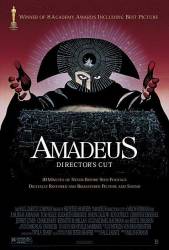Factual error: During the scene where Mozart is being carried away in his coffin by horse and cart there is a brief shot where he is being taken down a muddy path and a farmer is seen with his cows. If you look closely to the left side of the screen you can see a large overhead power line. If you look even more closely you can even see the wires coming out of the pylon. The movie is set in the 18th century and obviously it should not be there. (02:50:50)
Visible crew/equipment: When Mozart and family visit a parody on several operas of his in a public theater, in one part of the show little people appear from all sides of the stage. When the last of the little people (carrying a model of horse) hops through a paper wall on the side of the stage, you can see a man in jeans walking behind the set.
Continuity mistake: In the extended version of the DVD, there's a scene where Constanza goes to sleep with Salieri. In one shot there's a very prominent candle next to or just behind her on her right that smoking like it's just been extinguished. But from the front view there are no candles that close to her, and the ones a short distance away are all lit.
Continuity mistake: When Salieri has brought Mozart to bed and they are talking, Salieri is holding the candlestick. In the different views - from Mozart's and Salieri's - it can be seen that the angle he holds the candles changes. The line between the candles changesi. So Saleri held the candlestick in another angle the second time the scene was shot.
Continuity mistake: When Mozart is playing billiards (Director's Cut only) the balls move around on the table between camera shots, without him necessarily hitting any.
Continuity mistake: In the scene where Salieri is helping Mozart with the requiem the candles change appearance - and not just downwards because they burn.
Visible crew/equipment: Mozart is composing The Requiem Mass when Constanze admits a late-night caller. The door she opens reflects a large, bright square of light that looks like a sun-lit window (only it's night) - or more likely, a studio reflector. (It's definitely not the burning candles. Wrong shape.). (01:55:00)
Factual error: In the scene where Constanza starts to undress in Salieri's rooms, it is revealed she is wearing a 1980s style strapless bustier with separate bust cups and lots of frothy lace. This is not historically accurate. Women wore corsets which shaped their torso into a conical shape, pushed the bust together and up, and they generally had shoulder straps. The corsets were also mostly unembellished, so as to keep a neat silhouette under tightly fitted dresses. (01:07:00)
Audio problem: When Constanze asks Salieri to look at Mozart's work, her mouth doesn't move when she says, "I don't mean that he's lazy... he works all day long."
Continuity mistake: Mozart's pianoforte is carried outside for the concert. But while the concert is going on, Salieri goes to Mozart's home, and the just-carried-out piano is still there.
Factual error: At the beginning of the movie when Salieri is first talking to the priest asking him if he recognizes some of his songs, they cut away to an opera. A woman can be seen descending stairs where there appears to be smoke falling down the stairs, which would have to be dry ice. While it was first discovered/observed in 1825, it wasn't commercially available until 1925.
Continuity mistake: In the opening scene when Salieri's servants offer him ice cream and cakes, the choppy servant gets ice cream on his nose. When seen from behind there is more ice on his nose than when seen from the front.
Factual error: During the ballet scene in the Marriage of Figaro, many of the costumes worn by the dancers have visible zips on them, which of course had not been invented then.
Factual error: The scene where Mozart is dictating the "Confutatis" to Salieri: though the real Salieri was, in truth, a very accomplished composer and musical expert, there is no way he could write down Mozart's melodies as quickly as he does in this scene. The ostinato string part is especially improbable - he writes down a combined 968 notes for four parts in less than 10 seconds. Obviously done for time purposes, but unrealistic all the same.
Continuity mistake: When Mozart and Salieri are discussing why Marriage of Figaro failed, a statue of a black man can be seen behind Mozart. In one shot, when Salieri invites Mozart to see his new piece, the statue isn't there. In the next shot, it's back. (01:50:25)
Continuity mistake: In opening scenes Salieri has blue eyes. After that his eyes are brown.
Continuity mistake: When Mozart checks on his sleeping son, the candles in the candle holder that he is carrying are much longer once he enters the room than before, when he is standing outside his son's room.
Continuity mistake: When Constanza goes to Salieri's house to show Mozart work, she is on his knees, the first sheet is in blank, then appear on the next scene fully written ("Director's cut", Blu Ray) (01:03:00 - 01:03:45)





